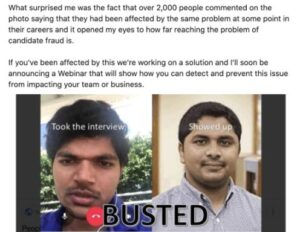Unfortunately, The Fake Candidate Scam is very common in the tech industry. As a Tech Specialized Staffing Agency, our recruitment experts often run into the “fake candidate” issue.
We know the importance of working quickly to fill your specialized tech position with a qualified candidate. It’s not easy to navigate the candidate market with the Fake Candidate Scam. This is why we do our best to tap into our extensive tech talent vault to make it easier to place candidates in suitable, specialized roles.
It is important to make your internal team aware of the Fake Candidate Scam. When you’re on the lookout to hire a candidate in Tech, it’s important to be aware of fraudulent activity. If something is fishy or doesn’t quite add up, it’s most likely a scam. It’s important to also make sure your team is aware and trained on how to spot fake H-1B visas or OPT candidates.
Sometimes, there are staffing agencies that might highlight candidates that seem perfect on paper but don’t fit the bill for the job in person. Often, these agencies might run a scam by forging documents and sending unqualified candidates to an in-person job interview.
Even though it is impossible to eliminate this issue, Focus GTS has developed a streamlined process for detecting and eliminating these “fake candidates” before they impact our clients and cost them both time and money.
How to Spot Unreal Talent and Resumes to Avoid The Fake Candidate Scam
Too Many In-Demand Skills
Look out for an overabundance of top skills or a list of highly reputable firms on a candidate’s resume. Often, fake candidates will represent themselves as A-List or highly qualified just to land an interview. Listen to your gut instinct the next time you look over a resume. If you’re questioning the companies that are listed or skeptical of the seemingly perfect skills that seem to pop up in every line, you may want to rethink the resume.
Missing or Partial Contact Information
Double-check the contact information that’s on file. Keep in mind that fake candidates might provide partial contact information such as an email address or phone, but not a permanent address. If there is no address on file, that might raise some red flags.
Dates Might Not Add Up
Research and figure out whether there are certain sections on the resume such as “years of experience” that don’t correlate to the candidate’s graduation date, for example. Ask yourself whether all of the employment dates and contract positions match. If there’s an odd gap or sudden job title leap, it’s important to question those details.
The Resume Does Not Match the Candidate’s Social Profile
Lastly, as with any process, it’s important to dig around and check a candidate’s portfolio. Linkedin and other social media platforms can be used to see if their work history and identity is consistent across platforms. If there are missing gaps or no Linkedin profile to be found, that might be another reason to suspect a possible fake candidate.
How Do You Handle The Fake Candidate Fraud?
- Screen: After you’ve screened a candidate during a phone interview, it’s crucial to conduct a second interview that confirms the identity of the person. This involves a follow-up video or in-person interview.
- Verify Identity: If you are doing a virtual interview, you can implement a verification process that involves having the candidate confirm their identity by holding a driver’s license or other photo ID to the camera.
- Ask the Candidate Not to Wear Earbuds During the Interview: Consider asking a candidate to remove their earbuds during the interview. “Fake candidates” might receive information from another source. You want to make sure the candidate is actually answering the questions truthfully, and not just being provided with answers by someone.
- Call References: Don’t just rely on the reference list the candidate provides… Be proactive and make the call to all past employers or HR departments to verify contacts.
An Example of H-1B Visa Fraud on Linkedin:
I know most people don’t do #throwbackthursday on LinkedIn, but I thought this would make a good story, and let you know what we’re doing to provide a solution to this problem.
Below there is a picture of a post I made two years ago on LinkedIn and went viral. The post was later removed by LinkedIn (I’m not sure why). A guy on my team at my previous firm did his first deal and had spoken to the candidate on the left multiple times (as you can see by the Facetime screenshot) and on the first day of the job the guy on the right showed up only to be fired on day one because the client was confident he wasn’t the one that they spoke to on the phone.

At first, I assumed there must be some sort of mistake. But then, I received the picture on the right from the manager that was taken for the new employee’s badge.
What surprised me was the fact that over 2,000 people commented on the photo. They were saying that they had been affected by the same problem at some point in their careers. It opened my eyes to how far-reaching the problem of candidate fraud is.
H-1B visa fraud scams pose a growing threat to the tech industry, not to mention lost revenue and productivity, as well as the uncovering of over $21 million in H-1B visa frauds.
What Happens if a Fake Candidate Goes Through the Recruiting Process?
If you run into the unfortunate situation of dealing with a fake candidate that passed all the hurdles of the screening and recruitment process, there is still plenty you can do to remedy the situation.
As a tech specialty staffing agency, we understand the pain and agony of the situation. Realizing that it was all a waste of time and resources can be frustrating.
Here’s what you can do to turn The Fake Candidate Scam situation around:
- Double-check the candidate’s photo IDs or other legal forms of identification. It is a good thing to double-check the candidate’s photo ID again when they arrive in-person.
- A fake candidate may show one piece of contact information, and then completely change it. This can raise red flags. If you suspect a fake candidate, inquire about the contact change.
- If you think a firm has already incorrectly hired a “fake candidate,” consider adding an extra background check layer. This includes sitting down with the candidate to assess how they’re doing on the job so far. This screening process would allow the company to get more information about the “fake candidate”. This is used to see if the answers match what was initially described in the first interview. You can ask for specific information ranging from skillsets or tools they’re currently using on the job. Ideally, the point of asking all of these questions is to figure out if they’re able to share information. These can be about previous teams, past supervisors, or anything to figure out if these answers exactly match.
- If you think you’ve hired a fake candidate, it’s important to identify inaccuracies based on what they initially provided. You can test their skills by assigning new projects to candidates based on the skillset information they gave in the initial interview. If the skills don’t match up despite what they initially told you, you might have been scammed.
- Lastly, consider matching a current employee with a new employee. Communication between these two individuals can uncover a lot of things, such as skill gaps or possible candidate fraud.

